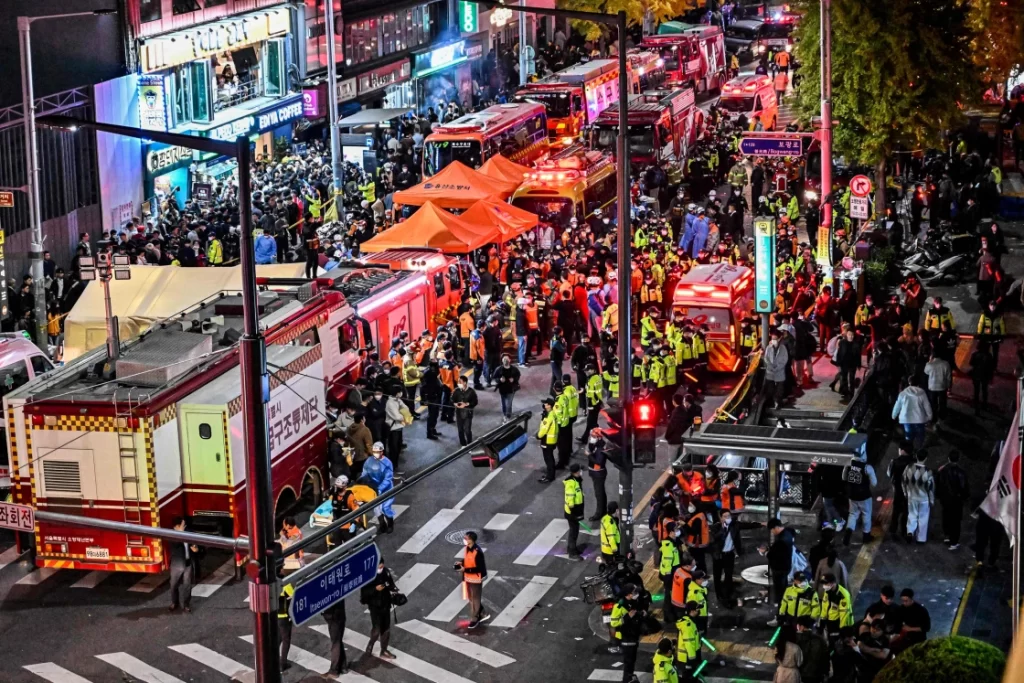On Saturday, October 29, 2022, more than 100,000 people were present during the crowd-crushing incident at the Halloween celebration in the Itaewon district of Seoul, South Korea. This tragic incident led to around 150 deaths, primarily composed of teens and young adults. The people of South Korea are mourning the loss of these lives while wondering how such an event could have happened, letting down the nation’s young generation once again.
Crowd crushing often occurs when the densities of crowds go above four people per square meter, and too many people are pushed into a confined area. When people have such little space, they can’t even inflate their lungs to breathe, resulting in compressive asphyxiation. These conditions were present at the Itaewon incident, with over five people per square meter and the location walling people in on all sides until many fell and were trampled. Clarifying the difference between mass panic and crowd crushing, crowdsourcing expert Professor Edwin Galea noted that a stampede is the incorrect definition of the incident, as this implies “blame to the victims for behaving in an irrational, self-destructive, unthinking and uncaring manner” and “people don’t die because they panic. They panic because they are dying,” calling attention to the fact that proper attention from management could have prevented such an event.
Regarding the crowd-crushing incident at Itaewon, authorities made numerous blunders simply out of carelessness. For instance, if authorities were to have enforced a management plan incorporating knowledge of the limitations of crowd control, routes to direct crowds in, the overall setting limits, and the need for monitors of crowd density, the incident could have been prevented altogether. However, instead, the absence of the situation manager of the 112 public order all-source situation room at the SMPA during the crowd crush would lead authorities to ignore numerous calls for help and riot police forces to focus on a march occurring near the presidential office instead. Nam In-Seok, a shop owner who witnessed the event on October 29, was interviewed by BBC news and stated, “Already at 19:00, I thought it was too crowded, and I was worried. It was very uncomfortable for the people walking, and the entrance to my shop was completely blocked.” He claims that many were coming from different directions and were screaming, “help me,” as they fell into piles. They could not breathe and escape despite Nam In-Seok’s efforts to help, and some claim that this is not the first time South Korea has failed to protect its younger generation.
Labeled the Sampo generation, South Korea’s youth has perpetually faced difficulties in economics and social mobility. Los Angeles Times noted that the younger generations have “often carried the burden of brokering South Korea’s critical transition into democracy, from the April revolution of 1960 to the June Democracy Movement of 1980 … these young people lack economic opportunities and clear direction for their futures. The list of things they won’t be able to count on is long: employment, home ownership, interpersonal relationships, hope, and health. Maybe even life itself.” With burdening economic crises at the start of young people’s careers, many in the Sampo generation have had difficulty rising and establishing stability in their lives and regarding their lives, and this tragic Itaewon incident showcases just how little respect the Sampo generation is treated with, as there have been many accusations of failure against authorities. One such authority, South Korea’s prime minister Han Duk-soo, even made an inappropriate joke during the press conference regarding the incident. This tragedy can be parallel to the sinking of the MV Sewol ferry in 2014, where 250 high school students passed away as the captain abandoned his ship and administrators avoided taking responsibility for the incident. Accordingly, some say that the Itaewon Halloween crowd crush emphasizes how much reform is still needed to protect the livelihood and, in this case, simply the lives of the youth.
Our hearts go out to all of the families and friends of those afflicted by the horrific tragedy that occurred during Itaewon’s Halloween celebrations. Many are calling out to the government for further reform, and eight years after a similar mass atrocity, President Yoon stated on his Facebook, “I believe making South Korea safer is the most sincere way to express condolences to the victims.” We hope he can keep this promise to ensure the safety of the younger generation and all South Korean citizens.
Works Cited
“Crowd Crushes: How Disasters Like Itaewon Happen, How Can They Be Prevented, And The ‘Stampede’ Myth”. The Guardian, 2022, https://www.theguardian.com/world/2022/nov/01/how-do-crowd-crushes-happen-stampede-myth-what-happened-in-the-seoul-itaewon-halloween-crush. Accessed 10 Nov 2022.
“Itaewon Crush: How South Korea Let Down Its Young People”. BBC News, 2022, https://www.bbc.com/news/world-asia-63509530. Accessed 10 Nov 2022.
“Op-Ed: The Tragedy In Seoul Should Force South Korean Society To Consider The Despair Of The Next Generation “. Los Angeles Times, 2022, https://www.latimes.com/opinion/story/2022-11-05/seoul-south-korea-halloween-crowd-itaewon-youth-generation. Accessed 10 Nov 2022.
“South Korea’S Yoon Apologizes For Halloween Stampede: ‘Unspeakable Tragedy’ – National | Globalnews.Ca”. Global News, 2022, https://globalnews.ca/news/9257177/south-korea-yoon-suk-yeol-halloween-stampede-apology/. Accessed 10 Nov 2022.
